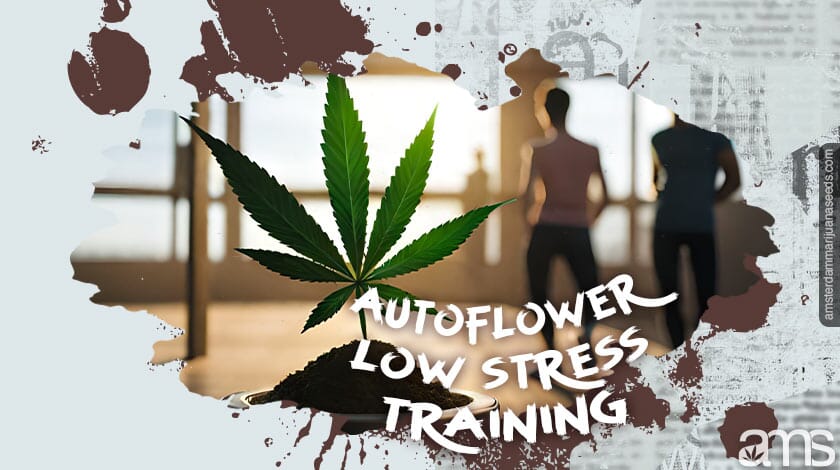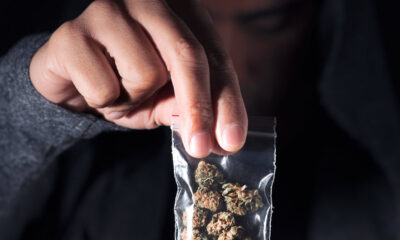marijuana growing
Autoflower low stress training
Published
1 year agoon
By
admin
You may have heard that autoflowering cannabis plants are low-maintenance and don’t require a lot of training, and that is true – but there are still ways you can help your cannabis plant produce more buds and increase your yields. One technique is called low stress training, or LST for short. Read on to learn how to properly low stress train your autoflowers for maximum results.
What is low stress training?
Low stress training is a technique that involves gently bending stems and shaping your weed plants to encourage them to grow in a certain way. By carefully manipulating the stems and leaves, you can control how the cannabis plant grows and ultimately increase your yields. Additionally, LST can help improve airflow and more light penetration to the lower parts of the weed plant, which is especially important for autoflowers that tend to grow shorter and bushier.
Benefits of low stress training on your cannabis plants
There are a few key benefits to low stress training for your autoflowering plants:
- Increased yields – By manipulating plant growth, you can encourage it to produce more buds.
- Improved light penetration – LST can help increase light penetration to the lower parts of the cannabis plant, which is especially important for autoflowers that tend to grow shorter and bushier.
- Stress relief – By gently bending and shaping the plant, you can help relieve stress which can ultimately lead to a healthier plant.
- Airflow – By improving airflow throughout the plant, you can help reduce the risk of
Types of low stress training
There are several types of cannabis low-stress training that outdoor and indoor growers can use to increase yields and improve the quality of their crops. (elke foto een voorbeeld van de methods)
Topping
- One popular plant training method is called topping, which involves cutting the top of the cannabis plant just above a set of leaves. This causes the plant to produce two new shoots, resulting in a fuller canopy and more bud sites.
FIM
- Another common technique is known as FIMing, or “finger-in-the-middle.” This involves gently pinching the stem of the plant between your thumb and forefinger, causing it to branch out and produce more buds.
SCROG
- Vertical SCROG (Screen of Green) allows you to maximize your growing area. This technique works by placing SCROG cables vertically in your grow tent. In doing so you can encourage a greater variety of bud sites for the crops. The side branch pull is also used to help hold down the main branches. The buds get quite heavy as the side branches get stronger now that they are no longer holding them.
Since Indica plants grow smaller and more dense than the Sativa, Indica and Indica-dominant hybrids are always the best choices. Because of its compact growth traits, it is more capable of low-stress training. Low-stress training can boost yield in the cannabis industry. Your yield will dramatically increase if you choose a potent Indica strain.
Here are some AMS Auto-flowering cannabis strains that work well for low-stress training:
These are just a few of the best Indica cannabis seeds for LST, but feel free to experiment with different strains to see what works best for you.
Can you use low stress training methods anywhere?
LST plant training can be used on autoflowers whether you’re growing cannabis plants indoors with artificial illumination or outside in the sunlight. LST is more frequently employed for indoor cannabis growers since it helps maximize production in a small area, but many outdoor farmers also choose to use these techniques to enhance the yield of their crops.
Why not use LST techniques to help ensure that every flowering plant has the chance to grow a big, fat, juicy nugget? Nobody wants a bunch of popcorn buds (the common name given to the low quality, low density buds produced by the lower side branches of a cannabis plant).
How to low stress train your autoflowers
To start, gently bend the main stem of the plant so that it’s horizontal. You can then use small clips or ties to secure the stem in place. Once the plant has recovered from the initial bending, it will begin to grow horizontally along the new stem. As the plant grows, you can continue to bend and tie the stems to encourage a more compact growth habit.
To ensure that your plant doesn’t become stressed during the training process, be sure to keep an eye on its leaves during the vegetative growth stage. If you see any leaves that are wilting or turning yellow, simply loosen the ties or clips so that the plant can recover.
Tips for getting the most out of your LST session
- Start low stress training – The earlier you begin low stress training, the better. This will give your plant more time to adjust to the new growth pattern and produce more buds. Start low stress training as soon as the first true leaves are showing.
- Be gentle – Remember that autoflowers are sensitive to stress, so be sure to handle them gently. Avoid tugging or pulling on the stems too hard, as this can damage the plant.
- Monitor your plant – Keep an eye on your plant during the training process and make sure that it’s not showing any signs of stress. If you see any wilting leaves or yellowing, simply loosen the ties or clips so that the plant can recover.
When to stop LST training
Low pressure exercises typically stop at the beginning of the bloom phase of your plant. When cannabis flowers, its initial blooming burst lasts several weeks and is evident in its growth. During the stretching period, maintain a flat canopy as the trees seek light. Approximately one month later, stretching stops and the marijuana plant will concentrate on the flowering stage. Generally, vegetative development is slow at this stage, so further training is not necessary. Another reason why low stress is stopped while flowering is to reduce bud damage.
Low stress training over high stress training methods
There are several ways to train your cannabis plants, and they all work fine, but with autoflowers it is advised that you only utilize low-stress training techniques. Your plant will finish up with a similar aspect whether you use LST or HST. When done correctly, training your autoflowering plant can mold it to the ideal height and structure. However, you should exercise caution because cannabis plants, particularly autoflowers, are susceptible to stress.
This occurs because autoflowers only have a short window before beginning to flower. igh-stress tactics on autoflowers can lead to decreased yields as stressed plants can take up to 7 days to recuperate and resume normal growth. With too much stress the plant could go into survival mode, which means that it could stunt growth, or weaken the plant.
Final thoughts on low stress training for autoflowering plants
By using low stress training techniques, you can help your autoflowers produce even more buds and increase your yields. So, why not give it a try? Be sure to start early in the vegetative growth stage and monitor your entire plant closely for any signs of stress. If done correctly, you’ll be rewarded with bigger and better buds during the flowering stage.
We’ve rounded up some commonly asked questions about low stress training. Please read below. Hopefully this will clear up some confusion you may have about this topic.
Can you do low stress training during flowering?
Weed growers have long used low stress training during flowering to increase yields and produce healthier plants. LST involves using techniques such as bending and topping to encourage the plant to produce more lateral growth. This results in a larger number of buds, which can lead to increased yields. LST can be performed throughout the flowering stage, but it is most effective when done early on.
Does low stress training increase yield?
Training with minimal stress can be extremely beneficial. These low stress training regime methods do require some time and effort, but they can be a great way to maximize your weed yield. If you are looking to get the most out of your plants, be sure to give low stress training a try.
Disclaimer: This content is meant for educational purposes only. It has been compiled with research from external sources. it is not meant to substitute any medical or legal advice. Please see your local laws for the legality of cannabis use.
You may like
-


Cannabis Rescheduling Takes The Next Steps
-


BREAKING NEWS: DEA Issues Notice of Proposed Rulemaking to Move Marijuana to Schedule III
-


Slovakia And Cannabis
-


The Illegal Cannabis Market in America is Still 3x Bigger Than the Legal Marijuana Market
-


Can Taking CBD While Pregnant Cause Glucose Intolerance in Male Offspring But Not Female Children?
-


AI is making cannabis cultivation smarter
marijuana growing
Boost Your Autoflowers with the Best Organic Fertilizers
Published
1 week agoon
May 9, 2024By
admin
If you are considering increasing your yield with fertilizers, you have many decisions to make. It starts with selecting one of the two principal types of cannabis fertilizers –synthetic or organic. You also need to understand the nutrients needed at different stages of cannabis growth. With this information, you can easily select the best fertilizer that fits your growing operation.
Fertilizer application for autoflowers
Auto-flowering strains are developed from the Cannabis ruderalis genetics. Cannabis strains with the auto-flowering trait depend on time and age to transition into the flowering stage. This means these plants automatically transition from the germination stage to flowering without the need for light cycle modifications. Since flowering is automatic, you would expect that these cannabis plants complete their growth cycle within a short window. However, within this period, they also rapidly absorb nutrients from the soil. These nutrients are needed for rapid cellular rearrangement, root system development, bud formations, and stem growth.
The nutrient absorption rate is high, and the plant can quickly exhaust the soil’s deposit of nutrients. This frequently happens in regions where the soil is practically poor in Nitrogen, potassium, and phosphorus. Autoflowering cannabis seeds, in many cases, need fertilizers to complete their growth cycle. Experienced cannabis farmers always have their preferred fertilizers handy as the plants start growing. In this review, we have compiled a list of the best organic fertilizers you should consider.
Why should you use organic fertilizers for autoflowers?
Both synthetic (commercially available) and organic (homemade) fertilizers are suitable for autoflowers. However, there are many reasons why you would want to consider using an organic fertilizer. Though not exclusive, here are some of the reasons to consider organic fertilizers;
1. Organic fertilizers are cheap on sale
If you are just starting on planting your first few stands of auto-flowers, you don’t want to overstretch your budget. Using organic fertilizers might help you spend less. Compared to synthetic fertilizers, the production cost for organic fertilizers is lower. The raw materials needed can be easily sourced from the environment. If you have the necessary skills, you can make these fertilizers right at home and apply them at no cost whatsoever.
2. Easily customizable
You can easily customize the nutrient content of your organic fertilizer. Synthetic fertilizers are sold in a fixed NPK ratio. Once produced, these fertilizers can only supply the component nutrients in a fixed ratio. For organic fertilizers, if you know which component supplies which nutrient, you can easily prepare fertilizer with different nutrient ratios.
3. No environmental and health hazards
Perhaps this is one of the biggest reasons many cannabis farmers prefer organic fertilizers for auto-flowers. The raw material is biodegradable, constituting no huge hazard to the environment. Since they also contain no synthetic chemicals, organic fertilizers constitute no serious health hazard. You can safely apply them without worries about getting a chemical reaction.
4. No adverse effect on harvest
You can be sure that your harvest is safe with organic fertilizers. Some synthetic fertilizers can interfere with the taste, flavor, and odor of cannabis plants. This is because residual chemicals present in these formulations can be absorbed directly into the plant’s system. With organic fertilizers, the formulation contains no residual chemicals as they are made from natural components. Your cannabis harvest is safe with its desirable features carefully preserved.
Our selection of the best organic fertilizers for auto-flowers
1. Organic superSoil
Getting it right with organic fertilizers all starts with the soil. The organic soil recipe –commonly described as ‘Supersoil’ –is one of the widely used organic growth mediums for auto-flowers. The soil is enriched with organic raw materials that are gradually decomposed over the years. The nutrients are decomposed over time into a form that the plant can easily absorb. There are various recipes and steps for mixing a SuperSoil. However, the components are always almost the same. You can modify the quantity of each component depending on the nutrient profile you need from the soil. One of the widely adopted mix ratios for autoflowers is the Ballpark recipe. Check the recipe below;
50% peat- or sphagnum-based soilless mix (provides the bulk of the medium)
10-20% mature compost (some organic nutrients + lots of microbes)
10% earthworm castings, or vermicompost (the same)
10% perlite (helps saturate the medium with O2, which is necessary for roots)
fungi/mycorrhizae/bacteria (turn raw organics into available plant food)
The fungi/mycorrhizae/bacteria component is very important. This organism plays two principal roles in Supersoils –they help decompose other components and also help the auto-flowers absorb these nutrients by binding to the plant root.
2. Bat guano
Bat poo, commonly called ‘Bat Guano,’ is a conventional organic fertilizer used in many planting operations. For thousands of years, local farmers with no access to synthetic fertilizers reportedly used bat guano. Since it works, this organic fertilizer option has survived many years of history. Today, rural farmers still use it as organically sourced fertilizer. Cannabis farmers also use Bat Guano as an organic source of Nitrogen, Phosphorus, and potassium. You can prepare bat guano in powder form or as a pre-made extract in the form of aerated tea.
Depending on the diet of the bat and its location, Bat Guano preparation can have a rich supply of both macro-and micronutrients needed by autoflowers.On harvesting the dried guano, you mix it into compost or apply it directly to the growth medium. Its rich deposit of phosphorus particularly makes it a preferred booster during the blooming period. Depending on the lay of your farm and the prevailing weather conditions, you can be creative with how you use Bat guano.
3. Manure
Manure can also serve as the right organic fertilizer for your autoflower. Primary manures are decomposed animal waste gathered from farms. Farmers who cultivate their cannabis in regions where livestock farming is a big deal prefer manual as an organic fertilizer. Since it can be readily sourced, the cost of production is very cheap. Manure offers a balanced nutrient profile for autoflowers. It also conditions the soil, making it a natural depot of plant nutrients. This deposit of nutrients makes it possible to grow autoflowers multiple times within the same cannabis planting season. For locally collected manures, composting is very important to make sure the manure does not damage the plant. Some of the most commonly prepared manure for autoflowers include;
- Chicken Manure: Manure sourced from chicken waste is high in Nitrogen. This makes a perfect option for autoflowers during the vegetative stage. Chicken manure also provides a lasting nutrient supply beyond the vegetative stage. Proper composting is needed.
- Sheep and Rabit manure: This manure is especially good for cannabis plants in the flowering stage. Although not often found in abundance, cheap rabbit manure comes naturally in an easy-to-apply pellet form.
- Composted Horses or Steers Manure: Unlike others, horses’ compost manure is produced as a cool material. This makes it easier to apply without burning the plant. They also produce a rich nutrient profile and contain beneficial organisms that can help autoflowers grow rapidly.
4. Compost tea
Though not very common, compost tea is another organic fertilizer you can consider for your autoflowers. This liquid concentrate contains soluble nutrients and microorganisms from compost materials. The key ingredients needed to make a compost team include compost. Worm casting, fish hydrolases, kelp, and molasses. The compost should have a large population of beneficial microorganisms. The worm castings are byproducts expelled from worms after digestion is completed. Kelp and molasses serve as food for fungi and bacteria that grow while the tea is brewing.
Once ready, the tea can be diluted and applied directly to the roots or sprayed on the autoflower leaves. Do not apply compost tea over an irrigation line to avoid clogging. It is also important that you apply a potent dose to a few autoflowers first and check for any adverse effects on the leaves after a few hours.
Bottom line
Growing your autoflowers with organic fertilizers is a good method of improving plant yield. The raw material needed for most organic fertilizers is locally available. You save time, energy, and resources if you choose organic fertilizers. You might also require the help of a botanist or agrochemical expert to help with any additional materials you might need. Buy autoflowering weed seeds here, great quality straight from Amsterdam
marijuana growing
“2024 Lunar Calendar Guide for Cannabis Cultivation Success”
Published
2 months agoon
March 12, 2024By
admin
Lunar Calendar for the 2024 Growing Season
Discover how the lunar phases in 2024 influence key moments in cultivation:
Germination: Perform germination during the full moon in fire signs (Aries, Leo, Sagittarius) on dates like January 25 and May 23.
Soil Preparation: Take advantage of specific dates, such as February 27 and March 24, to prepare the substrate during the waning moon in Virgo.
Transplant: Transplant during the waxing moon in water signs (Cancer, Scorpio, Pisces) on dates like March 20 and June 9.
Training and Pruning: Apply training techniques during the waxing moon in water constellations (Pisces, Cancer, Scorpio) on dates like March 11 and June 9.
Fertilization: Fertilize during the waning moon in water signs on dates like March 3 and June 29.
Harvest: Opt for harvesting in air constellations (Gemini, Libra, Aquarius) during the waxing moon or full moon on dates like September 17 and August 19.
Follow the lunar calendar and enhance your marijuana cultivation for exceptional harvests in 2024.
Cultivation of Cannabis at Home:
With the advancement of legalization in various parts of the world, there is a growing interest among individuals to cultivate their own marijuana plants at home. However, it is of utmost importance to approach this subject with responsibility and awareness, as marijuana cultivation involves legal and safety responsibilities. Additionally, proper cultivation management not only ensures compliance with regulations but also contributes to obtaining optimal plant quality, avoiding the use of chemicals that could harm its natural development and life cycle. This responsible approach not only promotes healthy cultivation but also safeguards the integrity of the environment and the well-being of those involved in this practice.
1. Legality and Regulations:
It is essential to start any cultivation project with a clear understanding of local laws and regulations. In many places, the possession and cultivation of marijuana are regulated, and even in areas where it is legal, there are limits on the number of allowed plants. Being informed about local regulations is crucial to avoid legal issues.
2. Seed Selection:
Choosing the right seeds is a crucial step. There are varieties with different levels of THC and CBD, as well as autoflowering options that simplify the process. Researching and selecting seeds that suit your needs and skills are key to successful cultivation.
3. Controlled Environment:
Creating a controlled environment is essential for the healthy growth of plants. Marijuana requires specific conditions of light, temperature, and humidity to thrive. Installing a suitable lighting system and regulating the climate are important considerations.
4. Nutrients and Irrigation:
Providing the right nutrients in the correct amounts is vital for plant development. Novice cultivators often underestimate the importance of a well-balanced nutrient program. Additionally, proper irrigation, avoiding both excess and scarcity, is fundamental to prevent issues such as mold and root rot.
5. Security and Discretion:
Maintaining security and discretion is crucial, especially if you live in an area where marijuana cultivation is subject to legal restrictions. Ensure that your cultivation space is protected and out of reach of unauthorized individuals.
100% Natural Cultivation:
With the appropriate knowledge and a consistent commitment to best practices, home cultivators can reap the rewards of a successful cultivation, respecting both laws and safety standards. It is crucial to consider the natural cycles of the moon, leveraging its benefits for plant development. Additionally, exploring various techniques that promote the natural growth of the plant is advisable, ensuring exceptional quality. It is worth noting that this process ensures a cultivation free of chemicals, which is essential to preserve plant quality and, consequently, the safety of human consumption.
marijuana growing
44K Job Opportunities by 2030
Published
3 months agoon
February 12, 2024By
admin
By: Juan Sebastian Chaves Gil
With sales exceeding $70 million during the II National Cannabis and Hemp Summit in Cali, it is clear that the medicinal and industrial sector of this crop is driving the country’s economy. Entrepreneurs, experts, and representatives were integral parts of this event, whose purpose is to demystify misconceptions about cannabis and support entrepreneurs in their formalization process.
Pedro Andrés Bravo, Secretary of Economic Development and Competitiveness of Valle, emphasized that this sector promotes inclusion and projects the creation of more than 44 thousand jobs by the year 2030. For this reason, Valle del Cauca leads the Business Justification and Diversification Index, pioneering in demonstrating the potential of this market.
The National Cannabis and Hemp Summit, led by the Government of Valle del Cauca, has become the most relevant event since the approval of the law on medicinal and industrial cannabis in the country.
According to Agronegocios, Valle del Cauca ranks fifth in national cannabis production, representing 2% in the year 2021.
Valle del Cauca stands out as the first department with a Medicinal and Industrial Cannabis production chain, coordinating the activities of 220 producers.
David Pérez, director of Mercannábico, the first Amazon-type marketplace for the cannabis industry in Colombia, emphasized the importance of these events to counteract the misinformation that has affected the sector. He highlighted that cannabis needs everyone to connect and that Colombia perceives it not as a problem but as a solution to medical ailments.
Estefanía Patiño Valencia, advisor to the Office of Social Management of Valle, pointed out that the summit managed to bring together the Ministries of Justice and Health, ICA, and Invima. All requests for the development of the industry were processed, and a departmental commitment was established with elected mayors, deputies, and councilors to work together for this sector.

Cannabis Rescheduling Takes The Next Steps

BREAKING NEWS: DEA Issues Notice of Proposed Rulemaking to Move Marijuana to Schedule III

Slovakia And Cannabis

The Illegal Cannabis Market in America is Still 3x Bigger Than the Legal Marijuana Market

Can Taking CBD While Pregnant Cause Glucose Intolerance in Male Offspring But Not Female Children?

AI is making cannabis cultivation smarter

New York Stooges – New York’s Cannabis Industry is Such a ClusterFudge, Gov. Hochul is Blaming Google and Yelp

Irrational Fear of High THC Cannabis Dispelled by New German Medical Study

Does Francis Ford Coppola Consume Weed

Can lemon-smelling weed cause less anxiety than others?

Distressed Cannabis Business Takeaways – Canna Law Blog™

United States: Alex Malyshev And Melinda Fellner Discuss The Intersection Of Tax And Cannabis In New Video Series – Part VI: Licensing (Video)

Drug Testing for Marijuana – The Joint Blog

What you Need to Know

Cannabis, alcohol firm SNDL loses CA$372.4 million in 2022

NCIA Write About Their Equity Scholarship Program

City Of Oakland Issues RFP For Employee Training Programs

It has been a wild news week – here’s how CBD and weed can help you relax

A new April 20 cannabis contest includes a $40,000 purse

UArizona launches online cannabis compliance online course
Trending
-

 Cannabis News1 year ago
Cannabis News1 year agoDistressed Cannabis Business Takeaways – Canna Law Blog™
-

 One-Hit Wonders1 year ago
One-Hit Wonders1 year agoUnited States: Alex Malyshev And Melinda Fellner Discuss The Intersection Of Tax And Cannabis In New Video Series – Part VI: Licensing (Video)
-

 drug testing5 months ago
drug testing5 months agoDrug Testing for Marijuana – The Joint Blog
-

 Cannabis 1011 year ago
Cannabis 1011 year agoWhat you Need to Know
-

 Marijuana Business Daily1 year ago
Marijuana Business Daily1 year agoCannabis, alcohol firm SNDL loses CA$372.4 million in 2022
-

 Education1 year ago
Education1 year agoNCIA Write About Their Equity Scholarship Program
-

 Education1 year ago
Education1 year agoCity Of Oakland Issues RFP For Employee Training Programs
-

 Cannabis1 year ago
Cannabis1 year agoIt has been a wild news week – here’s how CBD and weed can help you relax



